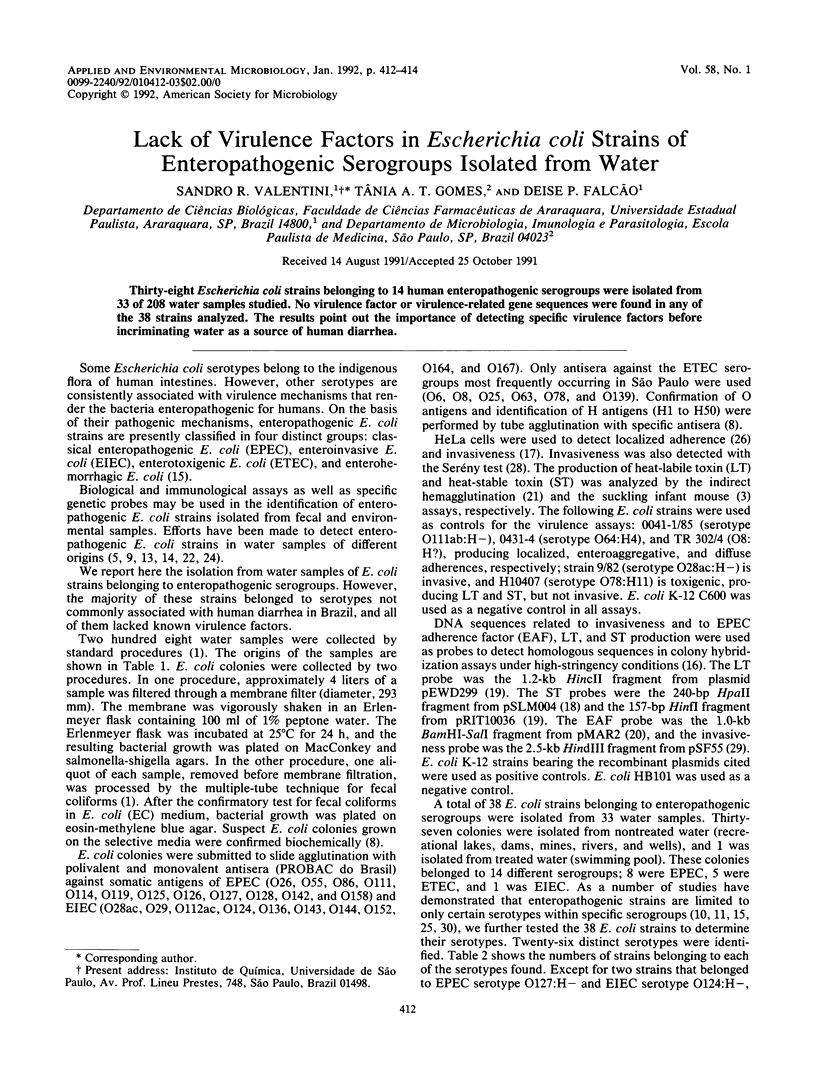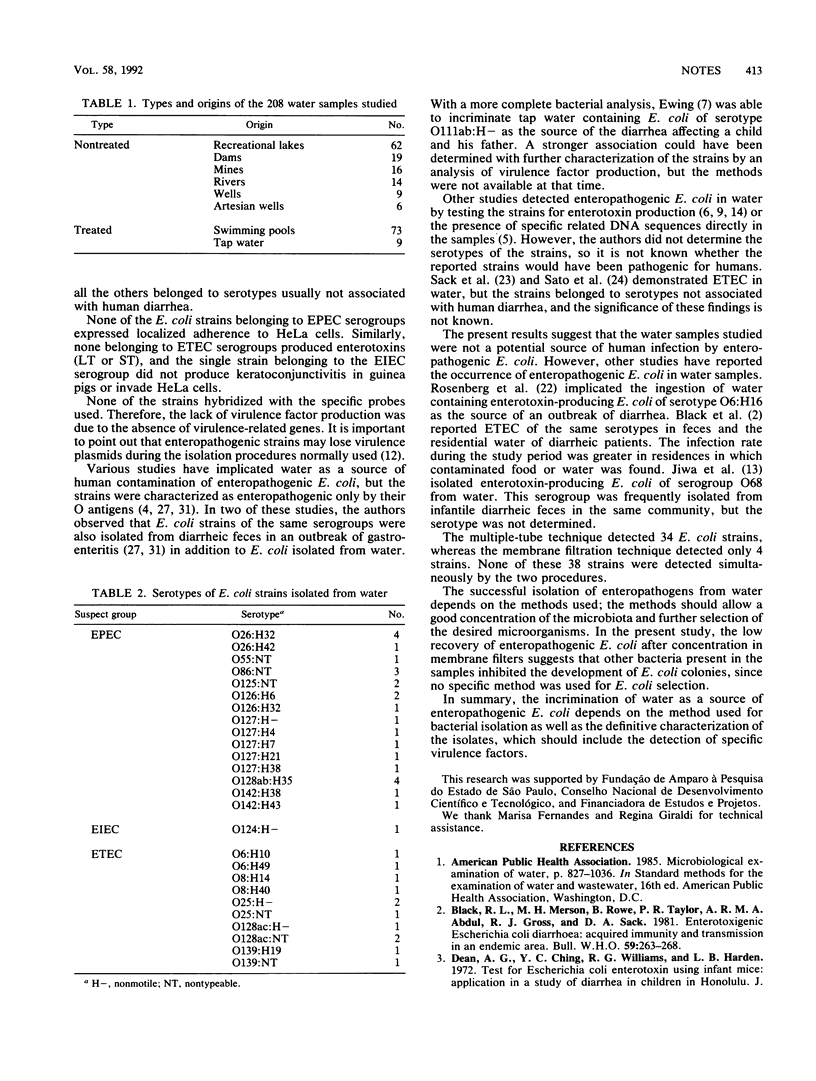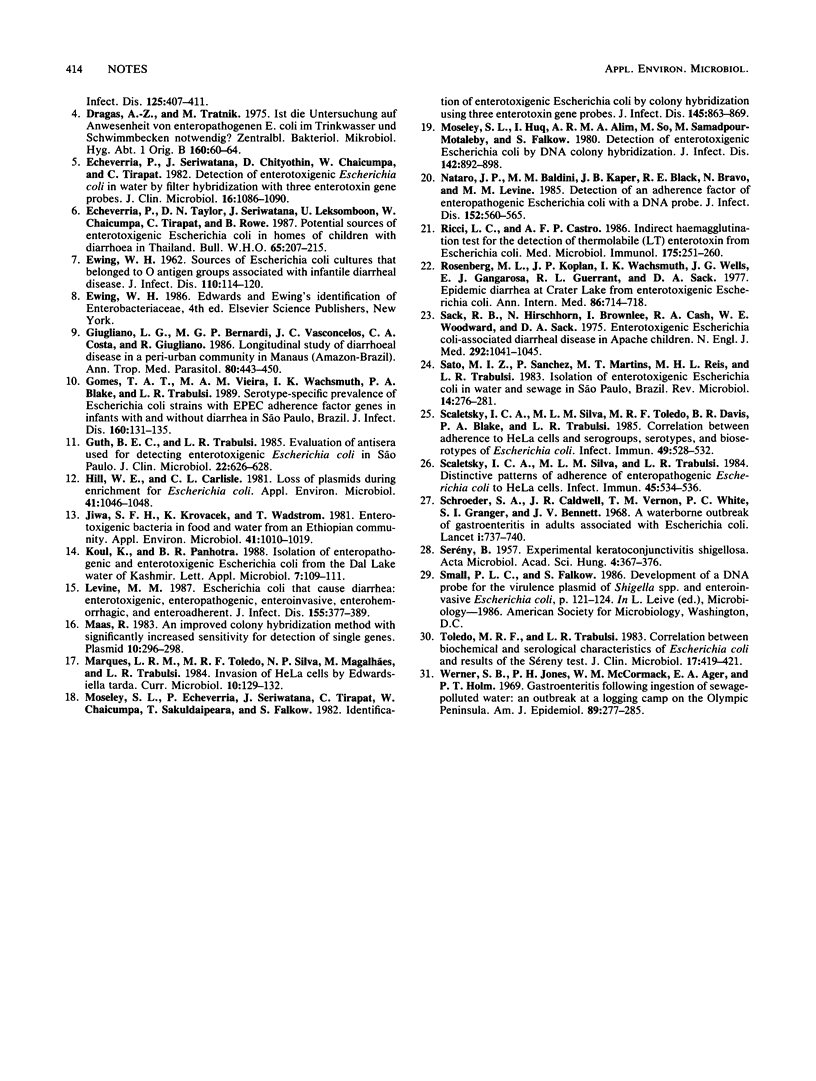Abstract
Thirty-eight Escherichia coli strains belonging to 14 human enteropathogenic serogroups were isolated from 33 of 208 water samples studied. No virulence factor or virulence-related gene sequences were found in any of the 38 strains analyzed. The results point out the importance of detecting specific virulence factors before incriminating water as a source of human diarrhea.
Full text
PDF


Selected References
These references are in PubMed. This may not be the complete list of references from this article.
- Black R. E., Merson M. H., Rowe B., Taylor P. R., Abdul Alim A. R., Gross R. J., Sack D. A. Enterotoxigenic Escherichia coli diarrhoea: acquired immunity and transmission in an endemic area. Bull World Health Organ. 1981;59(2):263–268. [PMC free article] [PubMed] [Google Scholar]
- Dragas A. Z., Tratnik M. Ist die Untersuchung auf Anwesenheit von enteropathogenen E. coli im Trinkwasser und Schwimmbecken notwendig? Zentralbl Bakteriol Orig B. 1975;160(1):60–64. [PubMed] [Google Scholar]
- EWING W. H. Sources of Escherichia coli cultures that belonged to O antigen groups associated with infantile diarrheal disease. J Infect Dis. 1962 Mar-Apr;110:114–120. doi: 10.1093/infdis/110.2.114. [DOI] [PubMed] [Google Scholar]
- Echeverria P., Seriwatana J., Chityothin O., Chaicumpa W., Tirapat C. Detection of enterotoxigenic Escherichia coli in water by filter hybridization with three enterotoxin gene probes. J Clin Microbiol. 1982 Dec;16(6):1086–1090. doi: 10.1128/jcm.16.6.1086-1090.1982. [DOI] [PMC free article] [PubMed] [Google Scholar]
- Echeverria P., Taylor D. N., Seriwatana J., Leksomboon U., Chaicumpa W., Tirapat C., Rowe B. Potential sources of enterotoxigenic Escherichia coli in homes of children with diarrhoea in Thailand. Bull World Health Organ. 1987;65(2):207–215. [PMC free article] [PubMed] [Google Scholar]
- Giugliano L. G., Bernardi M. G., Vasconcelos J. C., Costa C. A., Giugliano R. Longitudinal study of diarrhoeal disease in a peri-urban community in Manaus (Amazon-Brazil). Ann Trop Med Parasitol. 1986 Aug;80(4):443–450. doi: 10.1080/00034983.1986.11812045. [DOI] [PubMed] [Google Scholar]
- Gomes T. A., Vieira M. A., Wachsmuth I. K., Blake P. A., Trabulsi L. R. Serotype-specific prevalence of Escherichia coli strains with EPEC adherence factor genes in infants with and without diarrhea in São Paulo, Brazil. J Infect Dis. 1989 Jul;160(1):131–135. doi: 10.1093/infdis/160.1.131. [DOI] [PubMed] [Google Scholar]
- Guth B. E., Trabulsi L. R. Evaluation of antisera used for detecting enterotoxigenic Escherichia coli in Sao Paulo. J Clin Microbiol. 1985 Oct;22(4):626–628. doi: 10.1128/jcm.22.4.626-628.1985. [DOI] [PMC free article] [PubMed] [Google Scholar]
- Hill W. E., Carlisle C. L. Loss of plasmids during enrichment for Escherichia coli. Appl Environ Microbiol. 1981 Apr;41(4):1046–1048. doi: 10.1128/aem.41.4.1046-1048.1981. [DOI] [PMC free article] [PubMed] [Google Scholar]
- Jiwa S. F., Krovacek K., Wadström T. Enterotoxigenic bacteria in food and water from an Ethiopian community. Appl Environ Microbiol. 1981 Apr;41(4):1010–1019. doi: 10.1128/aem.41.4.1010-1019.1981. [DOI] [PMC free article] [PubMed] [Google Scholar]
- Levine M. M. Escherichia coli that cause diarrhea: enterotoxigenic, enteropathogenic, enteroinvasive, enterohemorrhagic, and enteroadherent. J Infect Dis. 1987 Mar;155(3):377–389. doi: 10.1093/infdis/155.3.377. [DOI] [PubMed] [Google Scholar]
- Maas R. An improved colony hybridization method with significantly increased sensitivity for detection of single genes. Plasmid. 1983 Nov;10(3):296–298. doi: 10.1016/0147-619x(83)90045-8. [DOI] [PubMed] [Google Scholar]
- Moseley S. L., Echeverria P., Seriwatana J., Tirapat C., Chaicumpa W., Sakuldaipeara T., Falkow S. Identification of enterotoxigenic Escherichia coli by colony hybridization using three enterotoxin gene probes. J Infect Dis. 1982 Jun;145(6):863–869. doi: 10.1093/infdis/145.6.863. [DOI] [PubMed] [Google Scholar]
- Moseley S. L., Huq I., Alim A. R., So M., Samadpour-Motalebi M., Falkow S. Detection of enterotoxigenic Escherichia coli by DNA colony hybridization. J Infect Dis. 1980 Dec;142(6):892–898. doi: 10.1093/infdis/142.6.892. [DOI] [PubMed] [Google Scholar]
- Nataro J. P., Baldini M. M., Kaper J. B., Black R. E., Bravo N., Levine M. M. Detection of an adherence factor of enteropathogenic Escherichia coli with a DNA probe. J Infect Dis. 1985 Sep;152(3):560–565. doi: 10.1093/infdis/152.3.560. [DOI] [PubMed] [Google Scholar]
- Ricci L. C., de Castro A. F. Indirect haemagglutination test for the detection of thermolabile (LT) enterotoxin from Escherichia coli. Med Microbiol Immunol. 1986;175(4):251–260. doi: 10.1007/BF02123733. [DOI] [PubMed] [Google Scholar]
- Rosenberg M. L., Koplan J. P., Wachsmuth I. K., Wells J. G., Gangarosa E. J., Guerrant R. L., Sack D. A. Epidemic diarrhea at Crater Lake from enterotoxigenic Escherichia coli. A large waterborne outbreak. Ann Intern Med. 1977 Jun;86(6):714–718. doi: 10.7326/0003-4819-86-6-714. [DOI] [PubMed] [Google Scholar]
- SERENY B. Experimental keratoconjunctivitis shigellosa. Acta Microbiol Acad Sci Hung. 1957;4(4):367–376. [PubMed] [Google Scholar]
- Sack R. B., Hirschhorn N., Brownlee I., Cash R. A., Woodward W. E., Sack D. A. Enterotoxigenic Escherichia-coli-associated diarrheal disease in Apache children. N Engl J Med. 1975 May 15;292(20):1041–1045. doi: 10.1056/NEJM197505152922001. [DOI] [PubMed] [Google Scholar]
- Scaletsky I. C., Silva M. L., Toledo M. R., Davis B. R., Blake P. A., Trabulsi L. R. Correlation between adherence to HeLa cells and serogroups, serotypes, and bioserotypes of Escherichia coli. Infect Immun. 1985 Sep;49(3):528–532. doi: 10.1128/iai.49.3.528-532.1985. [DOI] [PMC free article] [PubMed] [Google Scholar]
- Scaletsky I. C., Silva M. L., Trabulsi L. R. Distinctive patterns of adherence of enteropathogenic Escherichia coli to HeLa cells. Infect Immun. 1984 Aug;45(2):534–536. doi: 10.1128/iai.45.2.534-536.1984. [DOI] [PMC free article] [PubMed] [Google Scholar]
- Schroeder S. A., Caldwell J. R., Vernon T. M., White P. C., Granger S. I., Bennett J. V. A waterborne outbreak of gastroenteritis in adults associated with Escherichia coli. Lancet. 1968 Apr 6;1(7545):737–740. doi: 10.1016/s0140-6736(68)92181-8. [DOI] [PubMed] [Google Scholar]
- Toledo M. R., Trabulsi L. R. Correlation between biochemical and serological characteristics of Escherichia coli and results of the Serény test. J Clin Microbiol. 1983 Mar;17(3):419–421. doi: 10.1128/jcm.17.3.419-421.1983. [DOI] [PMC free article] [PubMed] [Google Scholar]
- Werner S. B., Jones P. H., McCormack W. M., Ager E. A., Holm P. T. Gastroenteritis following ingestion of sewage-polluted water: an outbreak at a logging camp on the Olympic Peninsula. Am J Epidemiol. 1969 Mar;89(3):277–285. doi: 10.1093/oxfordjournals.aje.a120941. [DOI] [PubMed] [Google Scholar]


